What are Euro 5 Motorcycle Regulations? Learn in simple terms what Euro Regulations for motorcycles are, when they started and how they’ve evolved. Did you know that they affect motorcycle standards worldwide? Countries like India, China, and Japan now follow European standards, which shows the significant impact that Euro regulations for motorcycles have now. So what are Euro 5 motorcycle regulations? And first, why do they exist?
In this article:
What are Euro 5 Motorcycle Regulations?
In a nutshell, the European Union wants cleaner air. Motorised transportation contributes a significant portion of air pollution to our atmosphere, which is more noticeable in towns and cities. To address this environmental concern, in 1992, the European Union introduced its first emission standards for cars, Euro 1. These standards focused on measuring the release of greenhouse gases like CO₂ (carbon dioxide) and other pollutants such as NOₓ (nitrogen oxides), particulate matter, or hydrocarbons from vehicles on the road.
Euro 1 (EC93) for Cars
Before we talk about motorcycles, the first car emission standard, Euro 1, was introduced in 1992 and was the first Europe-wide euro emissions standard. At this time, the Euro 1 implementation date for new car approvals was 1 July 1992, and for new car registrations, it was 31 December 1992.
New-type approvals require manufacturers to meet the latest Euro standard when introducing a new model or making significant changes to an existing one.
Euro 1 for cars was designed to test vehicle emissions – mainly hydrocarbons, nitrogen oxide, and particulate matter (for diesel engines). Other stipulations included the mandate for Catalytic converters for all new cars, and everyone was required to switch to unleaded petrol (fuel). For the scientists among you, the Euro 1 emission limits for cars were as follows:
- Petrol engines:
- Carbon Monoxide (CO): 2.72 g/km
- Hydrocarbons (HC) + Nitrogen Oxides (NOx): 0.97 g/km
- Diesel engines:
- Carbon Monoxide (CO): 2.72 g/km
- Hydrocarbons (HC) + Nitrogen Oxides (NOx): 0.97 g/km
- Particulate Matter (PM): 0.14 g/km
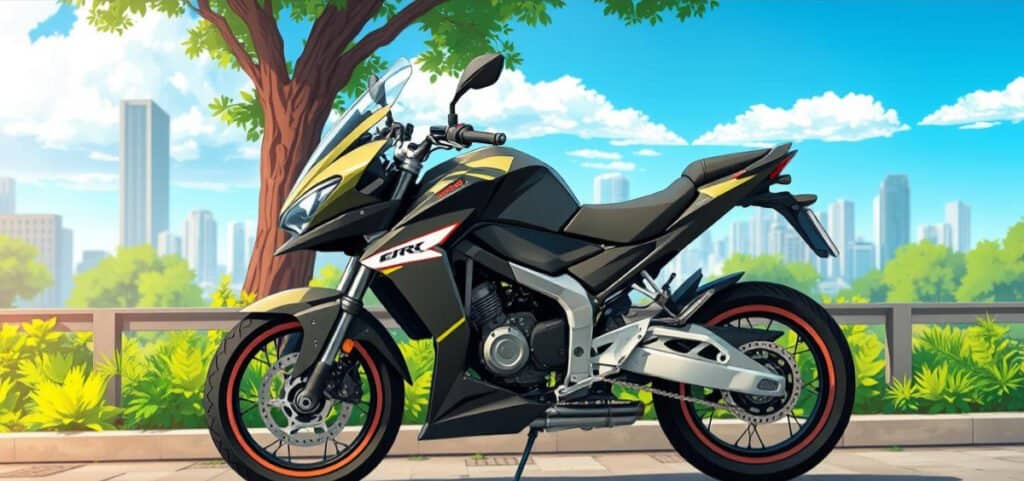
What does g/km stand for?
You will see the term g/km on this page. This stands for grams per kilometre and measures a specific pollutant per gram emitted by a vehicle per kilometre travelled. It is a measurement commonly used with emission standards and fuel efficiency ratings.
Environmental Impact
Lower g/km numbers indicate that a vehicle emits fewer pollutants. This is better for the environment, helps to combat global climate change and reduces air pollution.
What about Motorcycles?
Let’s focus on motorcycles. Euro emission regulations for motorcycles started with Euro 1 for motorcycles in 1999.
Euro 1 for Motorcycles
Seven years after Euro 1 for cars, emission standards for motorcycles (including mopeds and tricycles) came into effect with Euro 1 for Motorcycles implemented on 17 June 1999. The regulations were less stringent at this early stage of the emission standards game for bikes—Quite the contrast to Euro 5 or Euro 5+ coming in 2025. These were the Euro 1 emission limits for motorcycles:
- Carbon Monoxide (CO): 13.0 g/km
- Hydrocarbons (HC): 3.0 g/km
- Nitrogen Oxides (NOx): 0.3 g/km
Euro 2 for Motorcycles
In a continued quest to clean up European air even more, Euro 2 (for motorcycles) arrived in 2003. In fact, on January 1, 2003, Euro 2 was implemented for new motorcycle-type approvals. Twelve months later, on January 1, 2004, it was further implemented for all new motorcycles.
Euro 2 was designed to limit motorcycle emissions of hydrocarbons (HC), carbon monoxide (CO), and nitrogen oxides (NOx).
SCOPE: Euro 2 regulations were applied to motorcycles with engines over 50cc or capable of speeds over 45 km/h. REQUIREMENTS: (for manufacturers) The adoption of more advanced engine technologies and some use of catalytic converters. The following were the Euro 2 emission limits for motorcycles:
- Carbon Monoxide (CO): 5.5 g/km
- Hydrocarbons (HC): 1.0 g/km
- Nitrogen Oxides (NOx): 0.3 g/km
As the Euro emission regulations have evolved and become stricter, so too have the rules for motorcycle manufacturers. New requirements mean updated physical components, complex technology, and design rethinking.
Euro 3 for Motorcycles
Next to arrive in convenient numerological order was Euro 3 (for motorcycles) in 2006. Euro 3 strived to push for improved air quality by further tightening motorcycle emission limits, mainly for hydrocarbons (HC) and nitrogen oxides (NOx). Euro 3 was implemented on January 1, 2006, for new motorcycle-type approvals and a year later on January 1, 2007, for all new motorcycles.
REQUIREMENTS: More advanced emission controls, such as oxygen sensors, closed-loop catalytic converters, and improved fuel injection systems.
These were the Euro 3 emission limits for motorcycles:
- Carbon Monoxide (CO): 2.0 g/km
- Hydrocarbons (HC): 0.8 g/km
- Nitrogen Oxides (NOx): 0.15 g/km
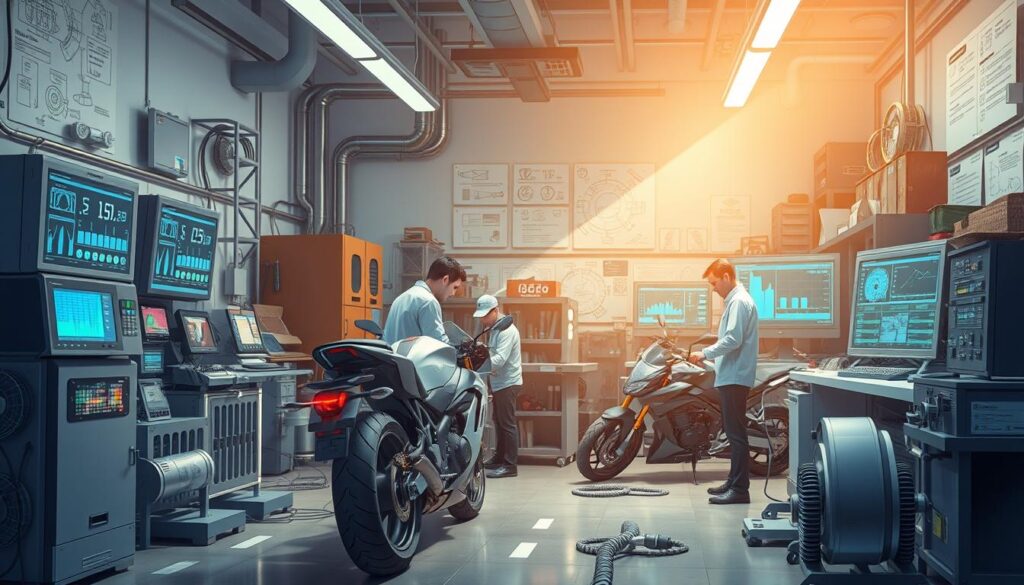
Euro 4 for Motorcycles
Not wishing to rest on their laurels for over a decade, Euro 4 came into effect for new motorcycle-type approvals on January 1, 2016. In prior fashion, Euro 4 was again implemented 12 months later for all new motorcycles on January 1, 2017. Having had a few years to consider aiding the future quality of Europe’s air and atmosphere, Euro 4 required new testing methods. These included durability testing for emission components and the introduction of evaporative emission controls. Euro 4 also brought a new focus: Addressing real-world emissions.
REQUIREMENTS: On-Board Diagnostics (OBD Stage I) to monitor emission systems.
Euro 4 required even stricter emission limitations:
- Carbon Monoxide (CO): 1.14 g/km
- Hydrocarbons (HC): 0.38 g/km
- Nitrogen Oxides (NOx): 0.07 g/km
Evaporative emission controls are systems designed to prevent the release of fuel vapours into the atmosphere from vehicle fuel systems. Fuel vapours are produced when fuel evaporates from the tank or fuel system due to heat or pressure changes.
The Evolving Euro Emission Standards
Let’s take a breather and look at what’s been happening in the background over the years up to this point. Considering that motorcycles make up less than 10% of all vehicles on European roads, the Euro Standards for cars, which make up over 87% of all vehicles, have continued to advance. By now, they are up to Euro 6. Let’s catch up with Euro 6 for car emission standards.
Euro 6 for Cars
Euro 6 was the latest standard to be released in Europe for cars (and light commercial vehicles) on September 1, 2014, for all new type approvals of vehicles. It became mandatory for all new cars sold from September 2015.
The Euro 6 standard aims to reduce harmful exhaust emissions by introducing stricter limits and a Real Driving Emissions (RDE) test. RDE tests measure vehicle emissions in real-world driving conditions, not controlled environments.
Here are the key emission limits for Euro 6 for cars:
- Carbon Monoxide (CO): 1 g/km
- Hydrocarbons (HC): 0.1 g/km
- Nitrogen Oxides (NOx): 0.06 g/km (petrol engines)
- Nitrogen Oxides (NOx): 0.08 g/km (diesel engines)
- Particulate Matter (PM): 0.0045 g/km (petrol engines)
- Particulate Matter (PM): 0.005 g/km (diesel engines)
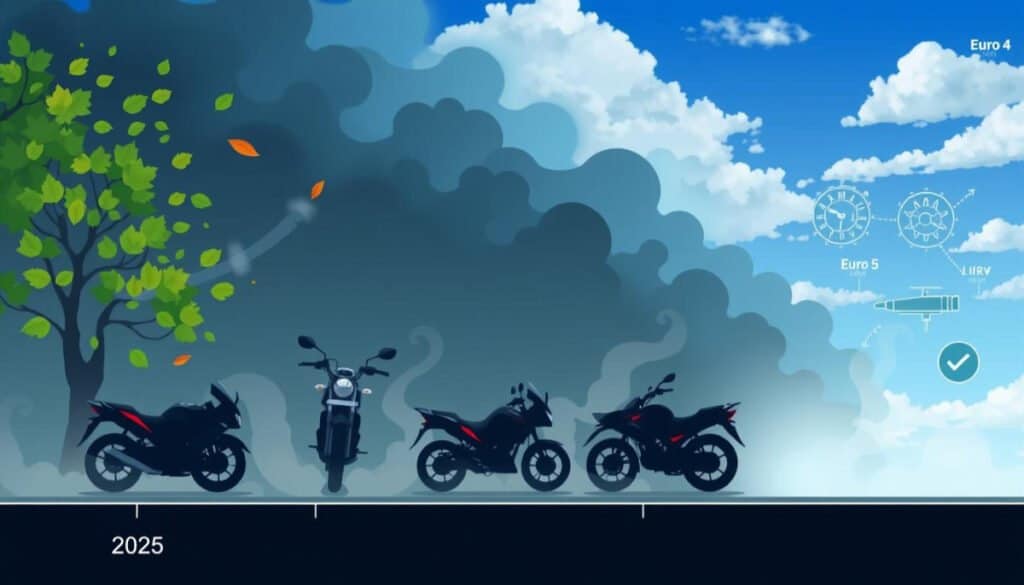
Euro 5 for Motorcycles
Back to bikes again! When writing this, we are in the Euro 5 era for motorcycles. Euro 5 was introduced in 2020. As you might expect by now, it was enforced for new motorcycle-type approvals on January 1, 2020. Manufacturers had the usual 12 months before it was applied to all new motorcycles on January 1, 2021.
PURPOSE OF EURO 5 FOR MOTORCYCLES: To align motorcycle emissions closer to those of cars under Euro 6.
Here are the key emission limits for Euro 5 for motorcycles:
- Carbon Monoxide (CO): 1.0 g/km
- Hydrocarbons (HC): 0.1 g/km
- Nitrogen Oxides (NOx): 0.06 g/km
- Particulate Number (PN): 6 × 10^11 particles per kilometre for engines producing more than 150 kW
Particulate Number (PN)
One new addition to the Euro 5 limits for motorcycles relates to Particulate Matter (PM). We can see that particulate matter has been part of the Euro emission limits for cars, going back to Euro 1. With Euro 5 for motorcycles, the emission standards have introduced a limit for particulate matter called Particulate Number (PN). This limit was only set for motorcycles with engines greater than 50cc, typically 125cc or more.
What is Euro 5+ for Motorcycles?
During recent discussions about European motorcycle regulations, we often hear the term Euro 5+. Euro 5+ is a transition phrase and informal description of the next step up from Euro 5 for motorcycles. It strives to push the latest requirements, which will be implemented in 7 days on 1 January 2025 for all new motorcycles. Here’s a list of the main focuses for Euro 5+’.
- Introduce the more advanced Onboard Diagnostics (OBD-II), which is capable of more comprehensive monitoring, detection, and reporting of failures in critical emissions-related components like catalytic converters or oxygen sensors.
- Durability Requirements: Extended durability testing to ensure that motorcycles maintain low emissions performance over a more extended period, higher mileage or the useful life of the bike.
- Introduce stricter emission limits – yet to be announced (possibly Euro 6).
- Real Driving Emissions (RDE) Testing: Testing motorcycles in real life to make sure their emissions performance equals that of laboratory tests.
- Stricter Noise Standards: Stricter noise limits are expected to be introduced as part of Euro 6.
- Emission Systems durability: This concerns not just the bikes but also the durability of system components. Manufacturers must prove that emission control systems remain effective for typically 20,000 km or more, depending on the bike.
Things are getting stricter for manufacturers
As you can see above, the Euro emission standards for motorcycles have become stricter, aligning with those of Euro 6 for cars. Motorcycle manufacturers must test for real-world emissions compliance and implement advanced OBD Stage II monitoring components, which are now tested for durability and include alerts for emission system failures. These requirements push motorcycle (and car) manufacturers to update or redesign their product range. This has led to an increase in the cost of some motorcycles, the cancelling of some previous models, and/or noticeable redesigns to what were once traditional styles. See Technical Challenges for Manufacturers below for a little more discussion.
Consequences of Euro Standards
Over the years, one of the more noticeable consequences or design changes seen by motorcyclists or consumers that have come with Euro Standards is the evolution and aesthetic appearance of the motorcycle exhaust system. If you click on the two bikes below, you can see that the Honda CB1000 Custom from 1983 (on the left) has a narrower and simpler exhaust than the brand-new 2025 Honda CB1000 Hornet. Motorcycle exhausts had to be redesigned to include catalytic converters and reduce emissions and noise. (See also the featured image at the top of this article.)
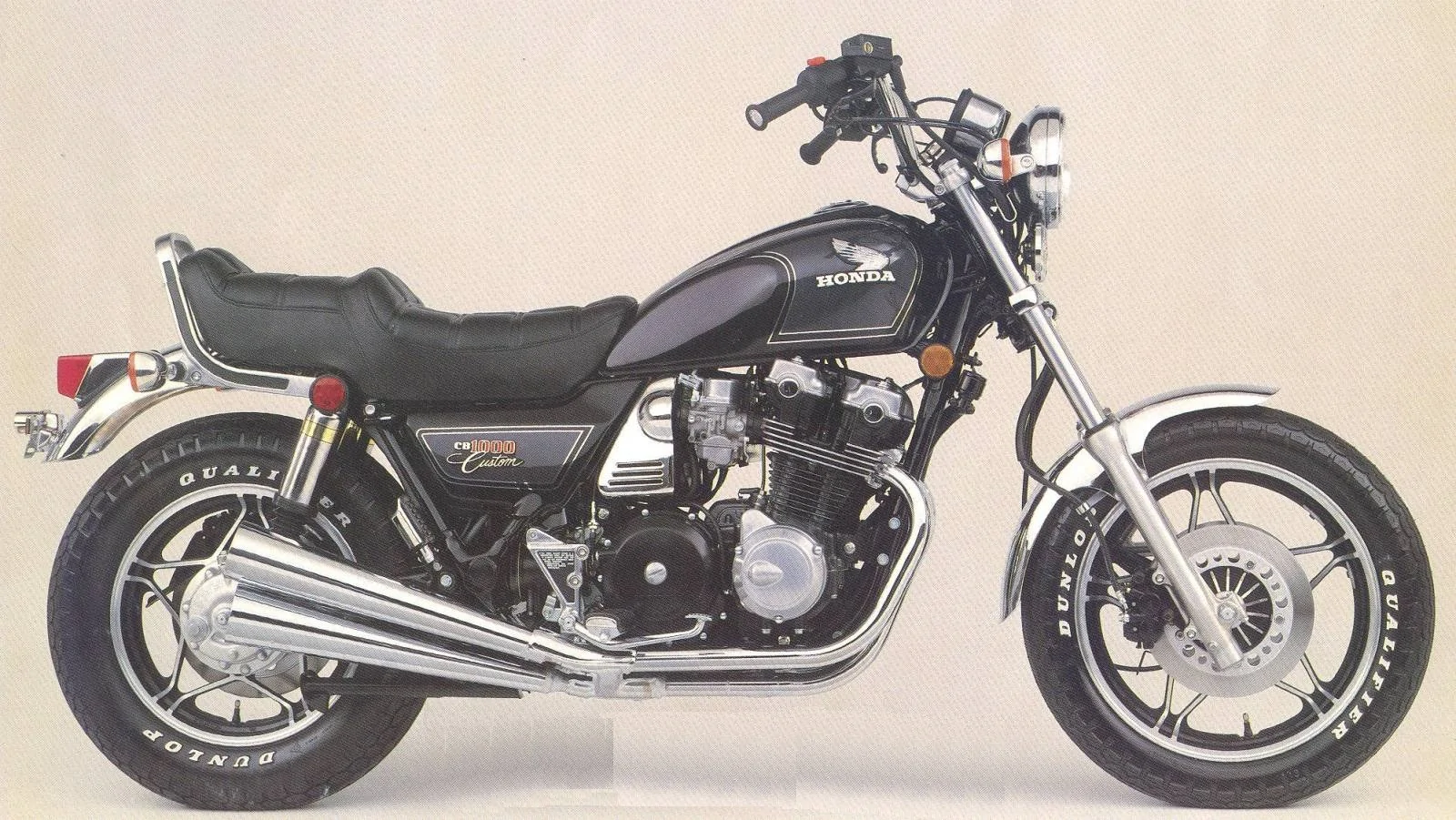
Honda CB 1000 Custom Motorcycles – Photos, Video, Specs, Reviews | Bike.Net

Euro 1 – Euro 5 Comparison
As I wrap up the Euro history part of this article, let’s look at the difference in Euro 1 emission limits for motorcycles compared to Euro 5 emission limits for motorcycles. Europe has reached quite a milestone!
EURO 1 (1999)
- Carbon Monoxide (CO): 13.0 g/km
- Hydrocarbons (HC): 3.0 g/km
- Nitrogen Oxides (NOx): 0.3 g/k
EURO 5 (2020)
- Carbon Monoxide (CO): 1 g/km
- Hydrocarbons (HC): 0.1 g/km
- Nitrogen Oxides (NOx): 0.06 g/km
As you can see, compared to the previous Euro 1 for bikes in 1999, Euro 5 has much more stringent requirements and demonstrates a successful push for a reduction in motorcycle pollutants over the past twenty-plus years.
Key Milestones in Emission Regulations
As many countries now follow European standards, reducing air pollution continues to be a win-win for everyone. Since Euro 1, Hydrocarbons and nitrogen oxides have fallen by 96.6%, and carbon monoxide emissions have decreased by 92.3%!
Euro 6 For Motorcycles and the Future of Motorcycle Emission Standards
Euro 6 for motorcycles has yet to be announced. I expect a renewed focus on noise pollution or noise limitations. Some riders are concerned that their bike’s effective life will be at the mercy of emission sensors or components. This could prove expensive if one cannot ride the same bike for many years. Only time will tell. I’ll update this article once any official Euro 6 for motorcycle information is released.
Emissions-Related Extras
In this part of the article, I’d like to cover some technical concepts and jargon to better understand things, especially from a manufacturer’s and consumer’s perspectives. Let’s cover a few of them.
Measuring a Motorcycle’s Performance
New tests don’t just check emissions. They also look at how well the bike performs. Ideally, for everyone, bikes can become more fuel-efficient and better for the environment without lacking power and performance. So, it’s not about stifling a motorcycle’s performance for the sake of emissions. The idea is to improve the engineering and maintain or even improve performance.
Bye Bye 1000cc Bikes for the Road
Those of you who keep an eye on the motorcycle landscape will notice that some manufacturers are focusing on 900cc bikes and discontinuing some litre bikes (1000cc). Old-school 1000cc race bikes for the road will be redundant in Europe’s future landscape or, so it seems.
Technical Challenges for Manufacturers
We mentioned that things are getting stricter for manufacturers. Below, we can dive a little deeper to see what motorcycle manufacturers have to think about when it comes to new bikes governed by Euro standards. Bike makers must balance emissions control with design. Reducing emissions while keeping engines strong and costs down is a technical challenge.
Cold Start Requirements
One tricky part of the new testing cycles is the cold start tests. These check emissions when the engine starts, when most pollutants are released. Many motorcycle enthusiasts like to listen to a cold engine startup, but you often notice more smoke or pollution escape the exhaust during a cold start.
Hydrocarbon Emissions in High-Revving Engines
One big problem for manufacturers is controlling hydrocarbon emissions in high-revving engines. These engines have longer valve durations, which can increase emissions. To solve this, makers are looking at new engine designs and ways to improve combustion. This is one of the main reasons why 1000cc sports bikes for the road will become a thing of the past.
Engines and Variable Valve Timing Technology
Another term you will encounter when discussing Euro motorcycle regulations and modern motorcycle engines is variable valve timing (VVT). VVT adjusts valve timing for different engine speeds and loads. It also boosts performance by improving the engine’s torque curve and drive. Here’s a quick video of engine pistons and valves opening and closing (minus the combustion).
With variable valve timing, engineers can finely adjust valves’ opening and closing times to optimise the engine for peak efficiency while reducing emissions.
VVT Cost Implications
Variable valve timing costs more, but the cost should decrease over time. With the promise of long-term gains in performance and emissions control, the initial investment cost should be worth it.
Fuel System Adaptations
Motorcycle manufacturers must redesign fuel systems to improve emissions and combustion for more efficient fuel delivery. For a layman like myself to visualise this, consider how a motorcycle throttle controls the amount of air (and fuel) entering the engine. When the rider turns the throttle grip, the butterfly valve in the throttle body opens, controlling the air entering the engine.
About the throttle, motorcycle systems can control how much air/fuel is used and when. For example, when reducing speed and coming to a stop, you can tune (instruct) the bike to cut off the fuel flow. This reduces fuel usage (and emissions) but might affect low-down power performance for the rider when they open up the throttle again. Motorcycles can be tuned (or mapped) to suit the rider’s preference in these and other cases. This leads us to ride-by-wire throttles.
Ride-by-Wire Throttles
Manufacturers nowadays implement ride-by-wire throttles on their bikes. With older traditional motorcycle throttles, twisting the grip pulls a cable connected to the throttle valve. The rider’s throttle input governs this mechanical cable operation. Traditional throttles are more complicated to synchronise with other engine components. As for power efficiency, safety and stricter emission standards, traditional cable throttle systems are too old-school.
Enter ride-by-wire!
Most modern motorbikes come with ride-by-wire throttles. These throttles house sensors in the throttle grip that send signals to an engine control unit (ECU). Depending on the bike’s specs, the ECU can calculate speed, gear, traction control, acceleration, braking or lean angle. With this data, the throttle valve can be adjusted electronically. With ride-by-wire throttles, manufacturers can better control fuel efficiency and power for the bike’s riding mode and riding conditions while reducing emissions. Ride-by-wire throttles also offer a smoother and more predictable throttle feel, translating to a safer and more comfortable ride.
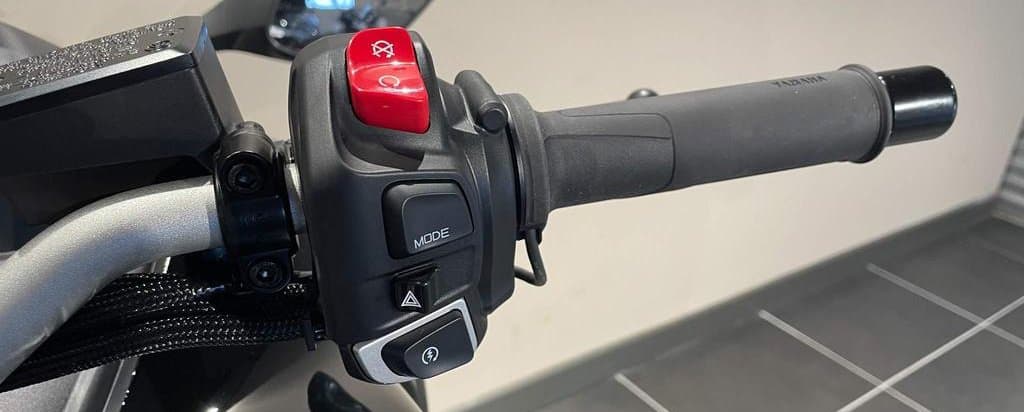
Niken GT throttle image via Stirlings Powersports ![]()
Yamaha is no stranger to ride-by-wire throttles, going back to their snowmobiles. My favourite motorcycle, the 2023 Yamaha Niken GT, uses their Yamaha Chip-Controlled Throttle (YCC-T), which I mention here.
Catalytic Converters
What is a Catalytic converter?
We must not summarise European Emission Standard requirements without a basic understanding of a catalytic converter. As you may recall from the motorcycle photos above, the catalytic converter is part of the vehicle exhaust system. Since most vehicle pollution comes from exhaust, catalytic converters are a crucial emissions control device.
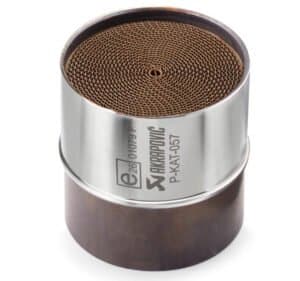
How do they work?
If you click on the image, you will see that a catalytic converter contains a mesh or honeycomb-type structure. This intricate structure is coated with metals like palladium, platinum and rhodium. When hot exhaust gases pass through a catalytic converter, these metals function as catalysts by triggering chemical reactions that convert harmful pollutants into less toxic substances. As you might expect by now, the harmful pollutants lessened are carbon monoxide (CO), hydrocarbons (HC), and nitrogen oxides (NOx).
Catalytic converters are vital for controlling emissions. However, they’ve grown more extensive and complex, posing design and cost challenges for motorcycle manufacturers looking to update their bikes to be Euro-friendly. This has led to some bikes being removed from European markets or a manufacturer’s product range.
Maintenance Considerations
How much will motorcycle maintenance cost with all of this new tech? With more components to check or potentially signal an error, one has to assume that servicing could take longer and cost more. With Euro 5+ for motorcycles, though, the durability requirements of the bike and emission systems should help. Keeping a glass-is-half-full attitude, hopefully, bikes will become more fuel-efficient, parts will last longer, and newer bikes will save you money on maintenance.
The Ban of New Gasoline-Powered Vehicles by 2035
As if all of this push for change and a healthier atmosphere was not enough, many countries led by the European Union have proposed banning the sale of new internal combustion engine (ICE) vehicles by 2035. Many people will probably have switched to electric cars and motorcycles by then. So far, this rule only applies to new vehicle sales. It will still be legal to drive your current gasoline-powered vehicle. Needless to say, ICE motorcycle and car sales could reach record-breaking highs just before 2035.
The European Union has led the charge with this 2035 ban but is closely followed by the UK, Canada, Norway, China, and California in the US.
Economic Commission for Europe – ECE R40, R47, and WMTC
The Economic Commission for Europe (ECE) sets the Guidelines for the emissions and performance of motorcycles (and mopeds) in Europe. If you research emissions testing, you will hear the term testing cycle. Euro 5 for motorcycles introduced the latest testing cycle, the Worldwide Harmonised Motorcycle Testing Cycle (WMTC). As the name suggests, WMTC strives to be a global testing standard. WMTC is a real-world testing cycle that better reflects real-world riding.
Previous testing cycles include ECE R40, which defined earlier motorcycle emission limits. Finally, ECE R47 focuses on motorcycle noise emission limits.
FAQ
What are Euro 5 motorcycle regulations?
Euro 5 for motorcycles rules are the newest emissions standards in the European Union. They cover two—and three-wheeled vehicles and aim to reduce emissions even more.
How do Euro 5 standards for motorcycles differ from Euro 4?
As the side-by-side table below shows, Euro 5 motorcycles emit 88% of the carbon monoxide compared to Euro 4 bikes. Euro 5 hydrocarbon emissions are 26% compared to Euro 4 bikes, and Euro 5 bikes emit 86% of the nitrogen oxides compared to Euro 4 bikes. Hydrocarbons win the race with this one.
Euro 4
- Carbon Monoxide (CO): 1.14 g/km
- Hydrocarbons (HC): 0.38 g/km
- Nitrogen Oxides (NOx): 0.07 g/km
Euro 5
- Carbon Monoxide (CO): 1 g/km
- Hydrocarbons (HC): 0.1 g/km
- Nitrogen Oxides (NOx): 0.06 g/km
What is particulate matter (PM)?
Particulate matter refers to tiny solid particles or liquid droplets suspended in the air. These particles differ in size, composition, and origin and can be inhaled into the lungs, potentially leading to health issues. They are also harmful to the environment. Euro 5 for motorcycles introduced a particulate number (PN) limit addressing the number of particles emitted by a motorcycle engine.
What are Hydrocarbons (HC)?
Hydrocarbons are organic compounds of carbon (C) and hydrogen (H) atoms. They are highly combustible and readily burn in the presence of oxygen, producing carbon dioxide, water, and heat. Hydrocarbons can be found in crude oil, natural gas, and coal. Burning hydrocarbons releases carbon dioxide, an undesirable greenhouse gas.
Which vehicle categories are affected by Euro 5 regulations?
Euro 5 rules apply to all L-category vehicles. This includes powered cycles, mopeds, motorcycles, motor tricycles, and quadricycles. Each type has its own emission limits and deadlines.
What technical challenges do manufacturers face with Euro 5?
Motorcycle manufacturers face a significant challenge in Meeting Euro 5 standards. They must balance catalyst efficiency, valve timing, fuel efficiency and combustion. Due to longer valve durations, high-revving engines have difficulty controlling hydrocarbon emissions and will likely be superseded.
How does Euro 5 impact motorcycle design and performance?
Motorcycle performance shouldn’t be affected too much. Bikes should become safer and more efficient. Designs must evolve to accommodate the latest sensors, components, and catalytic converters, which are key for emissions control but are big and expensive, often requiring exhaust system redesigns. Makers must find a balance between these changes and keeping performance up. See Consequences of Euro Standards for an example of exhaust systems.
What is the role of Variable Valve Timing (VVT) in meeting Euro 5 standards?
VVT helps control emissions and engine efficiency by adjusting valve timing for different speeds and loads. It also improves performance. But, VVT systems are costly and complicated to implement.
How is Fuel Efficiency improved?
Vehicles with lower CO₂ emissions usually have better fuel efficiency as burning less fuel produces less carbon dioxide. Also, see Fuel System Adaptations.
What is a closed-loop catalytic converter?
A closed-loop catalytic converter works alongside an oxygen sensor (lambda sensor), which monitors the oxygen level in the exhaust. It then communicates with the Engine Control Unit (ECU), which adjusts the air-fuel ratio (AFR) to optimise engine performance and minimise emissions.
How have testing procedures changed with Euro 5?
Euro 5 uses the Worldwide Harmonised Motorcycle Testing Cycle (WMTC). This replaced the old ECE R40 and ECE R47 cycles. The WMTC better reflects real-world riding.
What are the environmental benefits of Euro 5?
Like Euro 6 for cars, Euro 5 for motorcycles continues to reduce the amount of harmful pollutants like carbon monoxide, hydrocarbons, nitrogen oxides, and particulate matter released from motorcycles. Tighter emission limits significantly improve air quality.
How will Euro 6 affect consumer costs?
Euro 6 has yet to be announced, but it will likely make buying motorcycles more expensive. This is because of the cost of new tech and design changes. Maintenance might also go up due to more complex systems. But, in the long run, better fuel efficiency and longer-lasting engines could save you money.
How are global markets adapting to Euro 5 standards?
Major markets such as India, China, and Japan are aligning their emission regulations with those of Europe. This global shift is driving innovation in the motorcycle industry and may result in more affordable and standardized products worldwide.
Conclusion – A Breath of Fresh Air
I’ve enjoyed learning about Euro 5 motorcycle regulations and emission standards. These standards have gotten stricter, pushing motorcycle makers to be more creative and forward-thinking and taking us all in a healthier direction.
Larger 1000cc racing bikes for the road will likely become a thing of the past as lawmakers, health experts, and engineers strive to reduce pollution in any way they can. Thanks to Euro standards, many bikes are much cleaner and greener, with a massive reduction in emitted pollutants. Euro 5 and future bikes might be more expensive in the showroom for now, but they use less fuel and, as green transport, should hold their value when selling.
We’ve yet to find out how emission sensors and limits will affect the usable lifespan of our green bikes. However, Euro standards are undoubtedly improving things. Because WMTC is a worldwide testing standard, chances are most future bikes will be adequately priced or positioned to be a decent transport proposition.
Electric / Hybrid
Having said that, what about going electric? With motorcycle makers starting to release electric and hybrid motorcycles for the road, the time might come when electric bikes make sense. What do you guys think? Gasoline forever or go green? 2035 is just a decade out.
Euro Standards are helping our environment by reducing pollution. For that, we can all breathe a sigh of relief! Thanks for reading.
Invaluable sources: TransportPolicy.net was very useful for researching the European Union, as was Daze.eu.
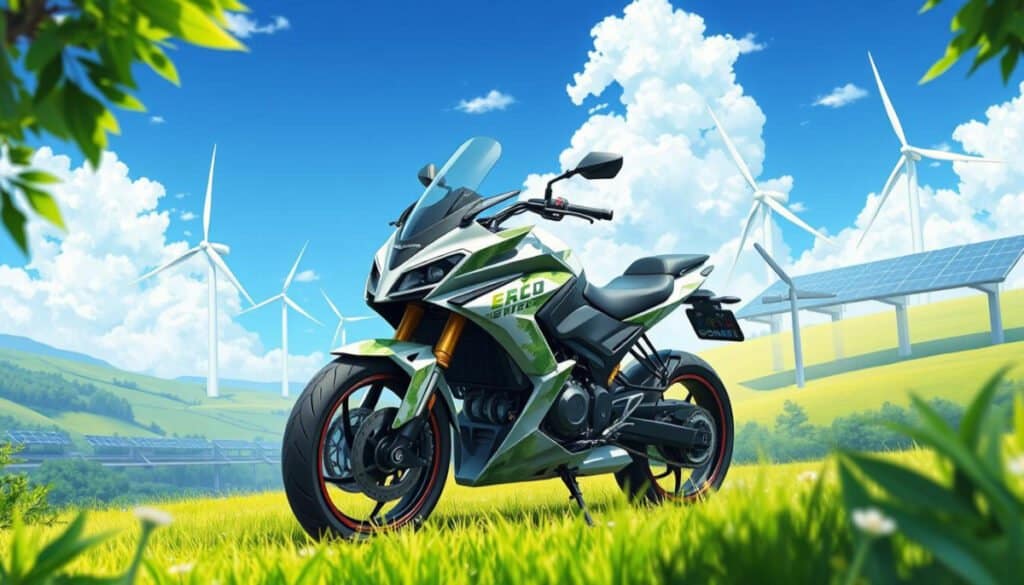





Merry Christmas! I hope you all have a Happy New Year!